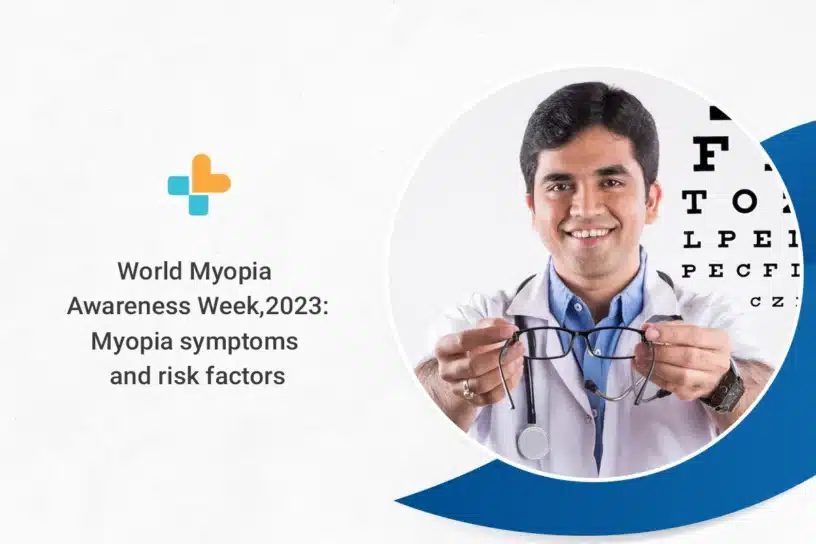World Myopia Awareness Week is celebrated every year from May 23-28 globally. The goal of World Myopia Awareness Week is to increase public understanding of Myopia, sometimes referred to as nearsightedness. During World Myopia Awareness Week, various organizations, eye care specialists, and researchers team up to spread awareness of Myopia, its causes, prevention, and treatment options. World Myopia Awareness Week usually includes events and public awareness campaigns like social media marketing, educational seminars, screenings, and public awareness efforts.

What is Myopia?
Myopia, also called as nearsightedness, is a common vision problem that is typically seen in individuals under the age of 20. It is a condition that occurs due to refractive error in the eye. This refractive error makes distant objects appear blurry and fuzzy. Patients having Myopia can see objects that are nearby with clarity.
What are the causes of Myopia?
Nearsightedness occurs due to a refractive error, which means the eye fails to correctly focus light. In the case of nearsighted individuals, the eye focuses light in front of the retina instead of onto it. The retina, which is present at the back of the eye, collects light and converts it into electrical signals which the brain eventually interprets as images. This misfocusing of light in front of the retina leads to blurred vision.
The underlying cause of this condition is typically a slight abnormality in the shape of the eye. If someone has Myopia, it is likely that their eyeball is longer than normal or their cornea, which is a transparent front covering of the eye, is excessively curved. These structural deviations can result in incorrect focusing of the eye.
What are the risk factors of Myopia?
Although anyone can develop Myopia, it is commonly seen affecting children and adolescents. This condition may worsen as the patient reaches their early 20s. There are a few risk factors that may increase a person’s risk of developing Myopia. These myopia risk factors include the following.
- A family history of Myopia
- Having health conditions such as diabetes
- Spending less time outside
- Regular visual stress
- Prolonged screen time
Symptoms of Myopia
A person with Myopia or nearsightedness is likely to experience the following myopia symptoms,
- Distant objects appearing fuzzy or blurry
- Clear appearance of objects kept nearby
- Strain on the eyes
- Squinting
- Headaches
- Tired eyes
Symptoms of Myopia in children may also include,
- Excessive blinking
- Sitting too close to the television
- Not being aware of the objects kept at a distance
- Rubbing eyes frequently
- Holding objects too close to the face
How is Myopia or nearsightedness diagnosed?
A standard eye examination can detect Myopia and is typically conducted to evaluate both vision and the overall health of the eyes.
Regular eye exams are important for individuals with Myopia or other eye conditions to monitor any prescription changes and screen for potentially serious eye disorders. The frequency of these exams depends on factors such as age, medical history, and the condition of the eyes.
The following tests are usually performed during a comprehensive eye examination,
- Medical history examination
- Refraction test
- Checking the pupil
- Visual acuity test
- Eye movement test
- Examination of the retina and the optic nerve
- Eye pressure test
Treatment of Myopia or nearsightedness
The following treatments can help in treating a patient with Myopia,
- Corrective lenses such as eyeglasses and contact lenses
- Orthokeratology (Corneal reshaping therapy)
- Surgery such as LASIK, SMILE, Epi- LASIK, Photorefractive keratectomy (PRK) or Intraocular lens implant
- Eye drops
Myopia complications
Myopia or nearsightedness can cause complications that may include the following,
- Excessive eye strain
- Increased risk of retina detachment
- Glaucoma
- Cataract
- Vision loss (rare)
- Reduced quality of life
- Poor performance in school
How can I prevent Myopia?
While Myopia has no cure, there are certain measures you can adopt to promote healthy eyes. It is particularly crucial to establish boundaries for children (and yourself) regarding activities that can cause eye strain in today’s digital age. Some of the practices that can help you improve your and your child’s eye health may include the following,
- Regular eye examinations
- Limiting screen time
- Not smoking
- Motivating the child to go outside more
- Wearing sunglasses when stepping outside
- Practicing the 20-20-20 rule, where if you are looking at the screen for 20 minutes, then look at something else that is 20 feet away for 20 seconds
- Avoiding straining the eyes by reading in dim lights
- Following your doctor’s instructions carefully
Conclusion
Myopia or nearsightedness is a type of eye condition that makes distant objects appear blurry or hazy. This World Myopia Awareness Week 2023, ensure to get an examination done for your family and yourself. If you have Myopia, then ensure to practice activities that will improve eye health. This World Myopia Awareness Week, educate parents about the various symptoms of Myopia to watch out for and get their children’s eyes examined if they notice any. Encourage parents to know the various risk factors of Myopia to reduce their children’s risk of developing Myopia. Create awareness among your family, friends and public about the importance of limiting screen time for good eye health.
At Ayu Health Network of Hospitals, our team of exceptional oncologists and eye surgeons provides the best treatment and care for all eye problems, including Myopia. Our hospitals are equipped with the best technologies and facilities to ensure that all eye surgeries are carried out with utmost care and safety. Please visit the website at www.ayu.health to know more.
Our Hospital Locations
Ophthalmology Surgery Hospitals in Chandigarh | Ophthalmology Surgery Hospitals in Bangalore | Ophthalmology Surgery Hospitals in Jaipur | Ophthalmology Surgery Hospitals in NCR | Ophthalmology Surgery Hospitals in Hyderabad
Our Doctors
Ophthalmology Surgery Doctors in Chandigarh | Ophthalmology Surgery Doctors in Bangalore | Ophthalmology Surgery Doctors in Jaipur | Ophthalmology Surgery Doctors in NCR | Ophthalmology Surgery Doctors in Hyderabad
About the Author

Dr. S. Goel
Dr. S. Goel is a renowned Internal Medicine Specialist currently practicing at Ayu Health, Bangalore. He is a Specialist in Internal Medicine, Diabetes HTN, Paediatric Care, and Family Medicine.




